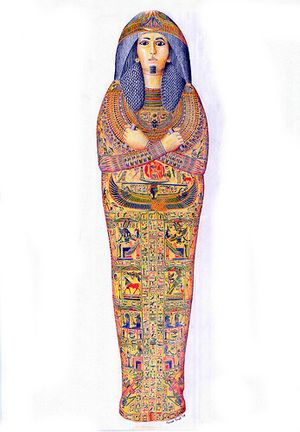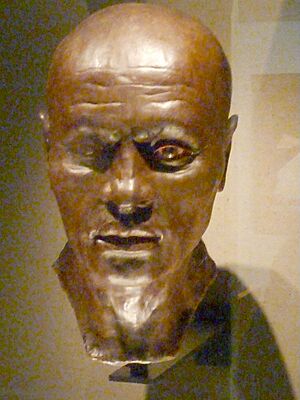Nesyamun facts for kids
Quick facts for kids NesyamunGod's father of Montu Scribe of the temple of Montu Scribe who lays out offerings Scribe who keeps tally of the cattle |
|
|---|---|

An artist's rendering of how the coffin lid of Nesyamun might have originally looked. The effect is intended to recall the illustrations made by Napoleon's surveyors in the Description of Egypt.
|
|
| Dynasty | 20th Dynasty |
| Pharaoh | Ramesses XI |
| Burial | Likely Deir el-Bahari |
Nesyamun, also known as Natsef-Amun or The Leeds Mummy, was an Ancient Egyptian priest. He lived around 1100 BC during the Twentieth Dynasty. He worked at the famous Karnak temple complex.
Nesyamun held important jobs there. He was a "god's father of Montu" and a "scribe of Montu". This meant he helped with daily food offerings to the gods. He also kept track of the temple's cattle. We don't know anything about his family.
His body was found in the early 1820s. An Italian trader named Giuseppe Passalacqua discovered it. Nesyamun's mummy traveled to Europe and was sold many times. Finally, it was bought by a museum in Leeds, England. In 1824, his mummy was one of the first to be studied scientifically. Today, his remains are at the Leeds City Museum.
Scientists have studied Nesyamun's mummy for many years. They learned he was between 50 and 60 years old when he died. In 2020, scientists even tried to recreate a sound from his mummified vocal cords!
Contents
Life as an Egyptian Priest
Nesyamun's name means "the one belonging to Amun." He was a priest and scribe at the huge Egyptian temple complex of Karnak. This temple was in Thebes, a very important city in ancient Egypt.
He lived during the Twentieth Dynasty. At that time, the High Priest of Amun ruled Thebes. Nesyamun's main jobs were linked to Montu, the Theban war god. He was called "god's father of Montu" and "scribe of the temple of Montu."
He also had other important roles. He was a "scribe who lays out offerings for all the gods." He also counted the cattle belonging to the gods Amun, Mut, and Khonsu. These titles show he was a senior leader in the temple.
We don't know much about Nesyamun's family. His coffin doesn't mention them. Some old museum guides say he married the daughter of Amenemtephis. Amenemtephis held a high position at the "Memnonium" temple. Nesyamun's son supposedly took over his grandfather's job. Nesyamun died around 1100 BC. He was buried near Hatshepsut's temple at Deir el-Bahari.
How Nesyamun Came to a Museum
Nesyamun's coffin and body were found in 1822 or 1823. An Italian trader, Giuseppe Passalacqua, found them. This was during his digs near the Deir el-Bahari temple. Nesyamun's mummy was then sent from Egypt to Trieste.
In 1823, a dealer named William Bullock bought Nesyamun in London. In 1824, a banker named John Blayds bought him. He bought Nesyamun for the Leeds Philosophical and Literary Society's museum. Nesyamun was the second mummy for their collection.
Early Scientific Study
Nesyamun's coffin was opened in late 1824. Scientists from the Leeds Philosophical and Literary Society studied his mummy. Their report was published in 1828. It was one of the first scientific studies of an Egyptian mummy.
The report described how the body was unwrapped. It also noted features of the mummy and its wrappings. They even tried to translate the hieroglyphs on the coffin. At that time, his name was written as "Natsif-Amon."
Museum Life and Bombing
Nesyamun was put on display on the first floor of the museum. He is mentioned in an 1854 guidebook. In the 1860s, he was moved to the museum's entrance area.
In the 1890s, a famous Egyptologist, Flinders Petrie, examined the coffin. He thought the coffin was older than the mummy inside it.
In the 1930s, Nesyamun was moved to a new display case. On March 15, 1941, the museum was bombed during the Leeds Blitz. Nesyamun was the only mummy not badly damaged. The bomb broke his mummy cover and scattered debris. But his coffin was mostly fine. The museum's other two mummies were destroyed. In the late 1960s, Nesyamun moved to a new museum building.

Modern Discoveries
In 1990, the Leeds City Museum asked the Manchester Mummy Team to study Nesyamun. This team uses many methods. They used X-rays and CT scans. They also looked at tissue samples.
They found that Nesyamun had arthritis in his neck and hip. He also had a type of parasitic worm. Scientists also created a Forensic facial reconstruction. This bust shows how he might have looked when he was alive.
Since 2002, the museum has studied his coffin's decorations. This helped them understand Nesyamun's roles as a priest. In 2008, the mummy moved to its current home at the Leeds City Museum.
Nesyamun's Coffin and Cover
Nesyamun's body was placed in a high-quality wooden coffin. It was covered with hieroglyphs. The coffin was likely made from sycomore fig wood. It was smoothed with plaster and painted in bright colors.
The coffin looks like a mummy. It shows Nesyamun wearing a large wig and flowers. He had a short beard, which is now broken off. A wide collar with a scarab beetle was across his chest. His arms were crossed, and he wore bracelets. His hands were fisted, holding amulets like ankhs (life symbols).
Below his arms, there is a boat with the god Amun-Re. Below that is the goddess Nut with her wings spread. The coffin lid has lines of text like mummy wrappings. Between the texts are scenes of Nesyamun offering gifts to gods.
The inscriptions ask for eternal life and to see the sun. They also ask to join the gods Osiris and Sokar. One text asks to attend a festival of the god Sokar. It mentions "onions at my neck the day of going round the walls." The inside of the coffin is plain black.
The mummy cover shows Nesyamun wrapped in white fabric. It also has his face, wig, and a floral headband. A broad collar and winged scarab are on his chest. Below is a boat with a solar scarab, flanked by Isis and Nephthys. Nut is again shown kneeling, protecting him with her wings. The inscriptions on the cover are similar to the coffin's.
The coffin is in good shape. But it has a crack and some modern repairs. The mummy cover was badly damaged in the 1941 bombing. It was originally white but is now painted black, perhaps to hide the damage.
Nesyamun's Mummy: What We Learned
First Look Inside
Nesyamun's wrapped mummy was first examined in 1824. Scientists from the Leeds Philosophical and Literary Society did this. They found his body wrapped in many layers of linen fabric. There were at least 40 layers!
The outer layer was fine white cloth. Below that were many layers of wide bandages. Inside these were two floral garlands. They had red berries and lotus petals. In the wrappings near his face, they found a red leather ornament. It had figures of gods and the names of Ramesses XI. This ornament might have shown his important position.
The bandages were made from recycled clothing. Some pieces showed seams and repairs. An entire tunic was used as padding on his body. Some textiles might have come from temple linen.
When the body was unwrapped, it had a thick layer of "spicery." This substance still smelled faintly of cinnamon. His body cavity, mouth, and skull were filled with it. The mummy was well preserved. His skin was "grey, soft, and greasy." Scientists saw bandage marks on his face. All his hair, even eyebrows, was shaved. His mouth was slightly open, and his tongue stuck out. His brain was removed through his right nostril. His organs were removed through an incision on his left side. They were dried, wrapped, and put back inside his body.
Later Discoveries
Nesyamun was X-rayed in 1931–32 and again in 1964. In 1989, he was studied again by the Manchester Mummy Project. They found that the back of his skull was removed in 1824.
His teeth were worn down, which is normal for ancient Egyptians. He had lost some back teeth. He also had wear between his front teeth, making them peg-like. This might be from eating acidic fruits or cleaning his teeth too much. He had gum disease, but no cavities, suggesting a low-sugar diet.
His eyes showed nerve damage. This can be caused by conditions like diabetes or vitamin deficiency. Blood tests showed he had O-type blood.
He had a narrowed disc in his neck, which would have caused pain. His arms were extended, with hands on his thighs. His hands were removed in 1824. His manicured and hennaed nails suggest he didn't do much hard physical work. His left hip had osteoarthritis. His feet were normal but slightly misshapen from tight bandaging.
Nesyamun was about 5 feet 6 inches (168 cm) tall. He died in middle age, between 40 and 50 years old. We don't know why he died.
Voice Reconstruction Project
In 2020, scientists used a 2016 CT scan of Nesyamun. They used this data to create a 3D model of his vocal tract. This model copied his mummified mouth and throat.
They used the model to make a single vowel sound. This sound might be how the priest's voice sounded in his mummified state. Some experts have questioned if this project was ethical or truly valuable.
Images for kids


